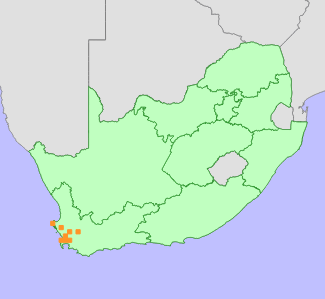|
Scientific Name | Anisodontea biflora (Desr.) Bates |
Higher Classification | Dicotyledons |
Family | MALVACEAE |
Synonyms | Malva albens E.Mey., Malva biflora Desr., Malva flexuosa in sense of Eckl. & Zeyh., not of Hornemann (1815), nor Gillies ex Hooker (1833) (misapplied name), Malva grosulariifolia of other authors, not of Cav. (misapplied name), Malva hispida C.Presl (later homonym), not of Moench (1794), nor Alefeld (1862), Malva villosa Thunb., Malva virgata Eckl. & Zeyh. (later homonym), not of Murray (1779), Malvastrum albens Harv., Malvastrum grosulariifolium in sense of Garcke, not of A.Gray, nor A.Gray & Harv. (misapplied name), Malveopsis albens (Harv.) Kuntze |
National Status |
Status and Criteria | Vulnerable B1ab(i,ii,iii,iv,v) |
Assessment Date | 2016/06/23 |
Assessor(s) | L. von Staden |
Justification | A range-restricted species (EOO 6844 km²), that is becoming increasingly rare due to ongoing habitat loss and degradation. There are an estimated five to eight remaining locations, but it is also possibly overlooked in areas where fires are excluded. |
Distribution |
Endemism | South African endemic |
Provincial distribution | Western Cape |
Range | Velddrif to Tulbagh and the Cape Peninsula. |
Habitat and Ecology |
Major system | Terrestrial |
Major habitats | Saldanha Granite Strandveld, Swartland Shale Renosterveld, Breede Shale Renosterveld, Peninsula Shale Renosterveld, Swartland Granite Renosterveld, Cape Winelands Shale Fynbos, Cape Flats Sand Fynbos, Swartland Alluvium Fynbos |
Description | Stony lower slopes and coastal flats, predominantly occurring in clay soils derived from shale, granite and silcrete. |
Threats |
| Urban expansion has caused the local extinction of this species on the Cape Flats around Cape Town and Kuils River, and habitat loss to urban expansion continues around Tygerberg, Malmesbury, Stellenbosch and on the Vredenburg Peninsula. Across the Swartland, it has lost more than 80% of its habitat to crop cultivation, and loss continues. Subpopulations at Tygerberg, Joostenberg, Stellenbosch and near Malmesbury are threatened by competition from spreading, unmanaged alien invasive plants. Apart from the Tygerberg Nature Reserve, lack of fire is a threat across this species' range. |
Population |
Anisodontea biflora is known from many historical records, but recent observations and collections are rare. It is now locally extinct over most of the Cape Flats, where it formerly occurred around Green Point, Black River and Kuils River. Further north, its habitat has been extensively transformed and fragmented. Field observations indicate that the species recruits in response to fire, but that it is fairly short-lived and rare in mature and senescent vegetation. Fires are excluded from many small, isolated renosterveld fragments, which means that dormant subpopulations could be easily overlooked. It has not been recorded in the Tulbagh Valley since 1894, but it possibly still persists in shale fynbos on the lower slopes of the Waaihoek Mountains near Mitchell's Pass. It continues to decline due to ongoing habitat loss and degradation.
|
Population trend | Decreasing |
Assessment History |
Taxon assessed |
Status and Criteria |
Citation/Red List version | | Anisodontea biflora (Desr.) Bates | VU B1ab(i,ii,iii,iv,v) | 2017.1 | | Anisodontea biflora (Desr.) Bates | Least Concern | Raimondo et al. (2009) | |
Bibliography |
Bates, D.M. 1969. Systematics of the South African genus Anisodontea. Gentes Herbarum 10(3):215-383.
Goldblatt, P. and Manning, J.C. 2000. Cape Plants: A conspectus of the Cape Flora of South Africa. Strelitzia 9. National Botanical Institute, Cape Town.
Manning, J.C. and Goldblatt, P. 2012. Plants of the Greater Cape Floristic Region 1: The Core Cape Flora. Strelitzia 29. South African National Biodiversity Institute, Pretoria.
Raimondo, D., von Staden, L., Foden, W., Victor, J.E., Helme, N.A., Turner, R.C., Kamundi, D.A. and Manyama, P.A. 2009. Red List of South African Plants. Strelitzia 25. South African National Biodiversity Institute, Pretoria.
|
Citation |
| von Staden, L. 2016. Anisodontea biflora (Desr.) Bates. National Assessment: Red List of South African Plants version . Accessed on 2025/09/10 |
 Comment on this assessment
Comment on this assessment


